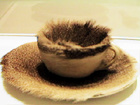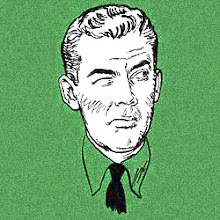 Piero Heliczer gave a reading in London in 1960 and a recording of it survives. The recording is here.
Piero Heliczer gave a reading in London in 1960 and a recording of it survives. The recording is here. David Lewis has written:
"Piero Heliczer was a key figure in the underground film movement in New York of the 1960s. Born in Italy, he initially broke into films after winning a talent contest at the age of four for the "most typical-looking Italian child." Heliczer played under the name of Pier Giorgio Heliczer in the two least-known commercial Italian films, typecast as the "cute fascist kid" during World War II. Tragically, when he was only seven years old, his father, a resistance fighter, was executed by Nazis allied with Mussolini. According to Heliczer's own account, he worked as an extra in Vittorio de Sica's masterwork Ladri di Biciclette (The Bicycle Thief, 1948), although this has yet to be verified. Heliczer's mother was not fond of Italian neorealism and its depiction of impoverished and dirty children, and decided to immigrate to the United States with her son sometime in the late '40s rather than attempt to further his career as a child actor. Heliczer graduated from high school in the top of his class and entered Harvard in 1955. He dropped out after two years and moved to Paris, where he established his imprint The Dead Language Press, mostly publishing his own literary works, but ultimately printing those of other authors, including Anselm Hollo, Gregory Corso, and The Beautiful Book of filmmaker Jack Smith. Heliczer's poetry was published with a fair amount of frequency in a variety of journals beside his own through about 1970."
 There's plenty more here.
There's plenty more here.Heliczer lived in London from 1960-1961 and, during that time, made his first film in collaboration with fledgling British filmmaker Jeff Keen (The Autumn Feast, 1961).
Tom Raworth wrote an article about Helizer and scanned it for the web.

 Is '60 the moment when the end of the end of the Old Left had been reached and the New Left began to emerge? Is it the final ascendancy, in certain scenes at least, of poetic postmodernity? Surely the publication of Donald Allen's The New American Poetry that year suggests this, but then again--once again--we look back on "New" here and see continuity. The rhetoric of the Kennedy-Nixon contest made much less of a dent than everyone (at the time as well as since) claimed, so one wonders why were such great claims made?
Is '60 the moment when the end of the end of the Old Left had been reached and the New Left began to emerge? Is it the final ascendancy, in certain scenes at least, of poetic postmodernity? Surely the publication of Donald Allen's The New American Poetry that year suggests this, but then again--once again--we look back on "New" here and see continuity. The rhetoric of the Kennedy-Nixon contest made much less of a dent than everyone (at the time as well as since) claimed, so one wonders why were such great claims made?  Had we come to expect "1960" to be truly ubiquitously modern in a way that the 1950s really were not--not quite? And what specifically does "modern" mean in the Kennedyesque talk then and now about the torch being passed to a new generation, etc.? The First Lady really meant "modernist" when Camelotians said "modern." What about the others across the new young cultural leadership? I've been surprised by how frequently the
Had we come to expect "1960" to be truly ubiquitously modern in a way that the 1950s really were not--not quite? And what specifically does "modern" mean in the Kennedyesque talk then and now about the torch being passed to a new generation, etc.? The First Lady really meant "modernist" when Camelotians said "modern." What about the others across the new young cultural leadership? I've been surprised by how frequently the  "Beat movement" was covered in 1960 in the mainstream press. I was expecting a fair measure but I've found tonnage. 1960 was the year when the figure of the beat was beginning to find acceptance, although still 80% of these stories are mocking, rebels-without-cause condescension. For anyone whose analysis made an impact nationally, do these antipolitical adolescents count as part of the "new young cultural leadership"? No, but rather than the two being opposites, they fall along a Continuum of the New American. Now that's a change for '60.
"Beat movement" was covered in 1960 in the mainstream press. I was expecting a fair measure but I've found tonnage. 1960 was the year when the figure of the beat was beginning to find acceptance, although still 80% of these stories are mocking, rebels-without-cause condescension. For anyone whose analysis made an impact nationally, do these antipolitical adolescents count as part of the "new young cultural leadership"? No, but rather than the two being opposites, they fall along a Continuum of the New American. Now that's a change for '60.







